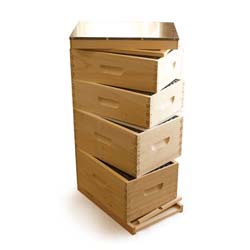Minimize stress on your bees when removing honey frames
Honey harvest can be stressful for honey bees, but with the right methods, you can minimize disruption and keep your colonies healthy and productive. Harvesting should always be done with care, leaving behind adequate stores to sustain bees through the winter months.
- Use bee escape boards or fume boards – These tools gently and naturally move bees down from honey supers, reducing the need for heavy brushing or shaking.
- Harvest at the right time of day – Midday, between 10 a.m. and 2 p.m., is ideal. Many foragers are out gathering nectar, so the hive population is lower and calmer.
- Prevent robbing behavior – Avoid dripping honey around the apiary. Spilled honey can attract robbers, which causes intense stress and fighting among colonies. Once robbing starts, it’s difficult to stop, so prevention is key.
- Avoid overcrowding – When you remove honey supers, you’re also reducing the space available in the hive. Make sure colonies aren’t left cramped, which can lead to agitation and health issues.
- Limit post-harvest inspections – After extraction, minimize hive disturbances so bees can recover and rebalance their colony without added stress.
- Why Stress Management Matters – Stress doesn’t just make bees defensive – it can weaken their immune systems, make them more vulnerable to parasites and disease, and negatively impact colony behavior. A calm, low-stress harvest helps ensure both the bees’ survival and your success as a beekeeper.
Should you feed your bees after removing the honey super?
If you are planning to harvest multiple times in a season, you do not want to feed your bees until you are finished harvesting honey for the year. Feeding before harvest will contaminate the honey stores, making your honey mostly whatever you feed your bees.
Ideally after harvest you will have left behind enough honey for them to make it through the winter without feeding. Sometimes that is easier said than done. For whatever reason (from taking more than intended or your bees just consume more honey stores than anticipated)
You can feed your bees after harvesting honey, but I would wait a few days afterward to begin that process. The smell of honey might linger in the air after harvesting and if you immediately begin feeding, the sweet aroma might trigger a robbing event. Waiting for the post-harvest frenzy to calm down might be better.
When it’s too cold outside to justify exploring the honey stores inside the hive, check their weight – a simple lift of the hive will help you determine how much honey they have. If the hive feels light, consider feeding them. If it feels heavy, they likely have adequate honey stores.
Harvesting honey isn’t just about what the beekeeper takes – it’s also about what the bees need to thrive. Responsible stewardship means striking a balance: enjoying the reward of your bees’ hard work without jeopardizing their survival. Taking too much honey can leave a colony vulnerable to starvation during the long months of winter. Always keep your bees’ wellbeing at the center of every beekeeping decision, especially as they prepare for winter. A healthy, well-prepared colony is the best investment you can make for both your bees and your future harvests.
